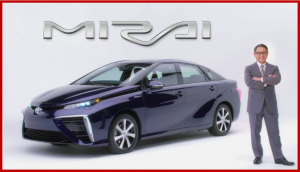
About 60% of the orders are from government offices and corporate fleets, and 40% from individual consumers.
During the first month since its launch in Japan on 15 December 2014, 1500 orders have been received for Toyota’s Mirai fuel cell sedan that lists for ¥7.24 million, or ~$63,000. Japanese governments will subsidize Mirai by about ¥3 million.
The strategy is to repeat the Prius hybrid success – more than 5 million sold globally since the late 1990s – whose sales were initially and to this day subsidized in Japan and the U.S. In the U.S., state and federal subsidies will total $12,500 when the Toyota Mirai fuel cell vehicle goes on sale later this year in California. It will list for $57,500, and have a $499 a month lease.
“Fuel cell vehicles are seen as the long term future for the auto industry but cost of development is prohibitively expensive and seen as only surviving the short term with subsidies,” said Art Wheaton, automotive expert and senior lecturer at Cornell University’s ILR School.
Last December, Toyota announced plans to sell approximately 400 Mirai models in Japan by the end of 2015. Due to the large volume of orders received, Toyota now forecasts a significantly longer time to delivery than originally expected.
About 60% of the orders are from government offices and corporate fleets, and 40% from individual consumers. Orders are mostly from Tokyo, Kanagawa Prefecture, Aichi Prefecture and Fukuoka Prefecture.
The Mirai’s motor is powered by electricity generated through a chemical reaction between airborne oxygen and hydrogen within an onboard fuel cell. Many industry experts predict that the fuel cell is the way ultimately to end the greenhouse gas emissions problem of fossil-fueled vehicles. There is a nagging question though about how the hydrogen is generated.


Toyota announced it will increase production of its Mirai fuel cell car. The hydrogen-powered sedan, launched in Japan on 15 December last year, and will be introduced in the U.S., UK and other European markets during 2015.
The new plan calls for production to increase from 700 units this year to approximately 2,000 in 2016 and around 3,000 in 2017.
Toyota decided the supply structure should be adjusted to reflect the level of demand for the vehicle, because of the 1,500 orders received in the first month of sales in Japan and the prospect of the model being launched in Europe and the U.S. later this year.
Following the production increases, sales plans for Japan, the US and Europe will be formulated, taking into consideration the level of hydrogen infrastructure development, energy policies, car purchasing subsidies, consumer demand, environmental regulations and other factors in each region.